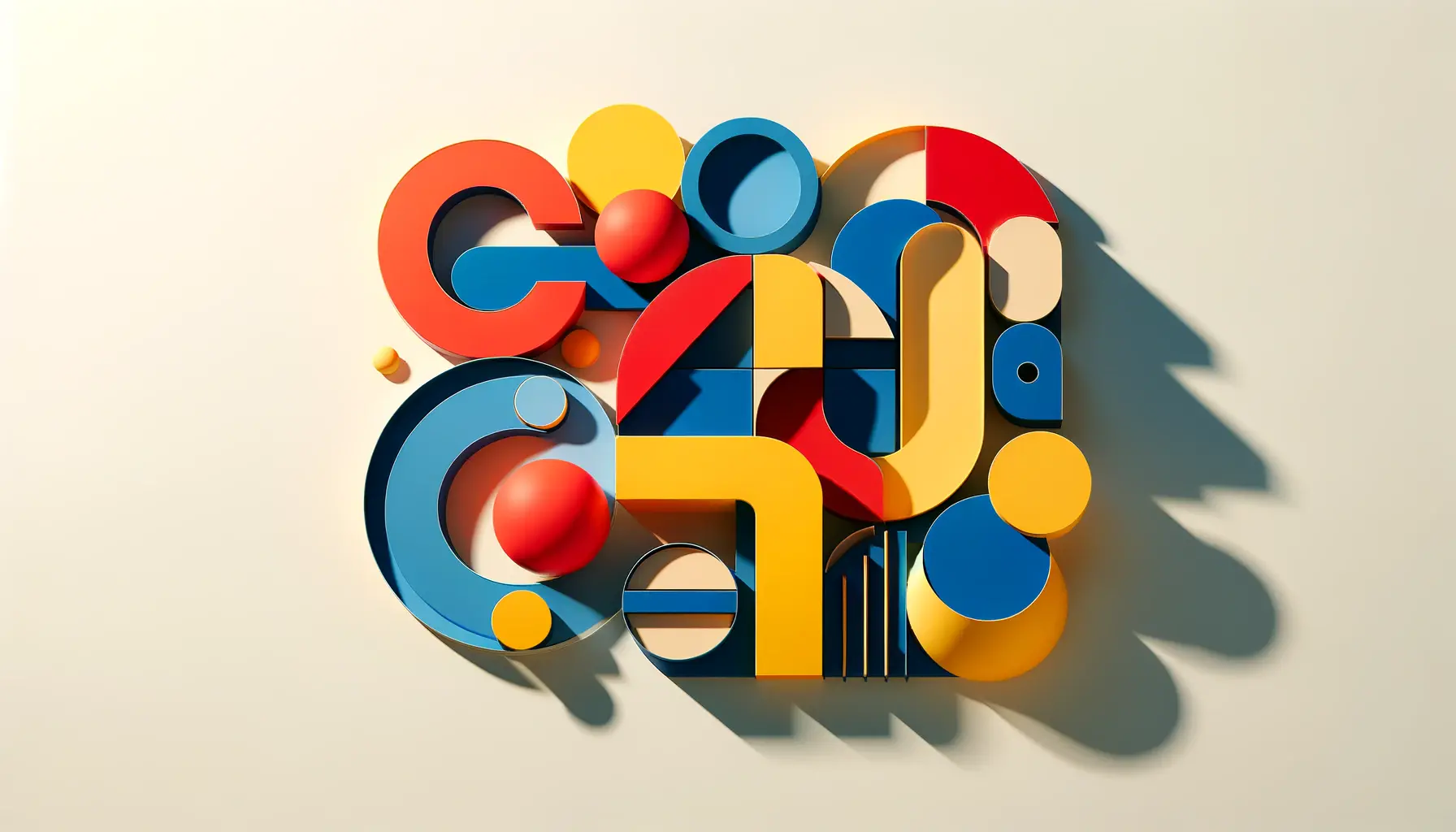Establishing a cohesive visual identity is paramount in the digital age, where first impressions are often made online.
This concept goes beyond mere aesthetics; it’s about crafting a consistent and recognizable brand experience across all customer touchpoints.
In the realm of web design, this means creating a website that not only looks appealing but also embodies the brand’s core values and messages.
The challenge lies in translating abstract brand concepts into concrete visual elements that resonate with the target audience, thereby enhancing brand recognition and loyalty.
The importance of a cohesive visual identity in web design cannot be overstated.
It serves as the digital face of a brand, often being the first point of contact for potential customers.
A well-designed website reflects professionalism, credibility, and trustworthiness, which are crucial for attracting and retaining customers.
Moreover, in a crowded digital landscape, a distinctive visual identity helps a brand stand out from its competitors, providing a competitive edge that can significantly impact its success.
- Understanding the Fundamentals of Visual Identity
- Strategies for Implementing Visual Consistency
- Enhancing Brand Identity with Visual Storytelling
- Integrating Brand Voice and Tone
- Optimizing for User Experience (UX)
- Leveraging Social Proof and Testimonials
- Adapting to Evolving Brand Strategies
- Forging Ahead: The Essence of Cohesive Visual Identity in Web Design
- FAQs on Building a Cohesive Visual Identity through Web Design
Understanding the Fundamentals of Visual Identity
The Role of Color in Branding
Color plays a pivotal role in creating a cohesive visual identity.
It’s not just about choosing attractive colors; it’s about selecting hues that convey the brand’s personality and values.
For instance, blue often represents trust and dependability, making it a popular choice for financial institutions.
Understanding color psychology and its impact on consumer perception is essential for developing a color scheme that enhances the brand’s message and emotional appeal.
Moreover, consistency in color usage across all web pages and online platforms is crucial for reinforcing brand recognition.
A consistent color palette makes the brand easily identifiable, creating a memorable experience for users.
This consistency extends beyond the website to include all marketing materials, social media profiles, and even product packaging, ensuring a unified brand presence both online and offline.
Typography and Brand Personality
Typography is another critical element of visual identity.
The choice of fonts should reflect the brand’s character, whether it’s traditional, modern, or whimsical.
Like color, typography influences how users perceive the brand and its messages.
A consistent typographic style across the website and other brand materials strengthens the visual identity and aids in building a cohesive brand image.
Choosing the right font combinations and ensuring readability across different devices and screen sizes are vital considerations in web design.
The goal is to enhance user experience while maintaining the brand’s visual integrity, making typography a powerful tool in the designer’s arsenal for building a cohesive visual identity.
A cohesive visual identity is not just about aesthetics; it’s a strategic tool for building brand recognition and loyalty.
Strategies for Implementing Visual Consistency
Implementing visual consistency across a brand’s web presence is a multifaceted process that involves careful planning and attention to detail.
Achieving this consistency ensures that the brand is immediately recognizable, reinforcing its identity and values at every user interaction.
Below are key strategies to ensure visual consistency, a cornerstone for building a cohesive visual identity through web design.
Developing a Comprehensive Style Guide
A style guide is an essential tool for maintaining visual consistency.
It serves as a reference document that outlines the brand’s design standards, from color palettes and typography to imagery and logo usage.
By adhering to a well-defined style guide, designers and content creators can ensure that every element on the website aligns with the brand’s visual identity, fostering a consistent brand experience.
- Color Palette: Specify primary, secondary, and accent colors along with their exact hex codes to ensure color consistency across all digital assets.
- Typography: Detail the brand’s chosen fonts, including styles for headings, body text, and any special text elements, to maintain typographic harmony.
- Imagery Style: Define the type of images, illustrations, and icons that fit the brand’s identity, ensuring that visual content supports the overall aesthetic.
Leveraging Responsive Design Principles
Responsive design is crucial for ensuring that a website’s visual identity remains consistent across various devices and screen sizes.
A responsive website automatically adjusts its layout and content to provide an optimal viewing experience, whether accessed on a desktop, tablet, or smartphone.
This adaptability is vital for maintaining visual consistency, as it ensures that the brand’s identity is presented accurately and effectively, regardless of how the audience accesses the site.
- Flexible Grids: Use flexible grid layouts that adapt to the screen size, keeping content structured and visually coherent.
- Adaptive Images: Implement techniques for scaling images so they look sharp and load efficiently on any device.
- Consistent User Interface Elements: Ensure that navigation menus, buttons, and other UI elements maintain a consistent appearance across devices.
Responsive design not only improves user experience but also reinforces your brand’s visual identity by ensuring consistency across all user touchpoints.
Enhancing Brand Identity with Visual Storytelling
Visual storytelling is a powerful technique in web design that can significantly enhance a brand’s identity.
It involves using visual elements to tell a story about the brand, its values, and its mission.
This approach can create a more engaging and memorable experience for users, helping to establish a strong emotional connection with the brand.
Effective visual storytelling requires a strategic blend of images, color, typography, and layout to convey the brand’s narrative cohesively.
When implemented correctly, visual storytelling can transform a website from a mere information hub into a compelling brand story platform.
This transformation not only captivates users but also deepens their understanding of the brand, fostering loyalty and trust.
Below are ways to leverage visual storytelling in web design to bolster brand identity.
Utilizing High-Quality Imagery
High-quality, authentic images can communicate a brand’s essence more effectively than words alone.
These images should reflect the brand’s personality and values, whether through candid photographs, professional shots, or custom illustrations.
By consistently using imagery that aligns with the brand’s story, businesses can create a visual narrative that resonates with their audience.
- Emotional Impact: Choose images that evoke the desired emotional response from the audience, whether it’s inspiration, trust, or excitement.
- Brand Alignment: Ensure all visual content reflects the brand’s identity and supports its overall narrative.
Creating a Cohesive Layout
The layout of a website plays a crucial role in visual storytelling.
A well-organized layout guides users through the brand’s story, highlighting key messages and reinforcing the brand’s identity.
Effective use of space, alignment, and hierarchy can direct attention to the most important elements, making the brand’s story more compelling and accessible.
- Consistent Navigation: A consistent and intuitive navigation structure helps users explore the brand’s story without confusion or frustration.
- Strategic Use of Space: Adequate spacing between elements can enhance readability and focus attention on key aspects of the brand’s narrative.
Incorporating visual storytelling into your web design not only enhances the user experience but also strengthens the brand’s identity, making it more memorable and impactful.
Integrating Brand Voice and Tone
The integration of brand voice and tone into web design is a subtle yet powerful way to reinforce a cohesive visual identity.
While visual elements capture the eye, the brand voice and tone speak directly to the heart and mind of the audience.
This combination ensures that the brand’s personality is consistently communicated, not just through what is seen, but also through what is read and perceived.
Crafting a unique brand voice involves aligning the language, style, and emotion of the content with the brand’s overall identity and values.
Effective communication of the brand voice and tone through web design requires meticulous attention to detail.
It’s about ensuring that every piece of text, from the homepage headlines to the call-to-action buttons, reflects the brand’s character.
This consistency in voice and tone across all web content helps to create a more immersive and unified brand experience for users.
Choosing the Right Words
Language is a powerful tool in conveying brand personality.
The choice of words, whether formal, casual, technical, or playful, should mirror the brand’s identity and appeal to its target audience.
This alignment helps in building a connection with the audience, making the brand more relatable and engaging.
- Consistency: Maintain a consistent style and tone across all web pages to reinforce the brand’s identity.
- Engagement: Use language that encourages interaction and engagement, making the website more dynamic and user-friendly.
Aligning Content with Visual Elements
The synergy between content and visual elements is crucial for a cohesive visual identity.
Text and visuals should complement each other, each enhancing the message of the other.
For instance, a bold and adventurous brand voice should be matched with vibrant colors and dynamic imagery.
This alignment ensures that the brand’s message is conveyed more effectively, leaving a lasting impression on the user.
- Visual-Textual Harmony: Ensure that the visual style and textual content work together to reinforce the brand’s message and identity.
- Emotional Resonance: Use visuals and text that together evoke the desired emotional response, strengthening the brand’s connection with its audience.
A cohesive visual identity is not just seen; it’s also heard through the brand’s voice and tone, making every interaction with the website a true reflection of the brand’s essence.
Optimizing for User Experience (UX)
Optimizing a website for user experience (UX) is crucial in building a cohesive visual identity.
UX design focuses on the user’s journey through the website, aiming to make it as intuitive and enjoyable as possible.
A positive UX reinforces the brand’s identity by ensuring that interactions with the brand are smooth, satisfying, and memorable.
This involves a careful balance of visual design, content, and functionality, all tailored to meet the user’s needs and preferences.
A well-optimized UX design not only supports the visual identity but also significantly enhances it.
By providing a seamless and engaging user experience, the brand’s identity is experienced in a positive light, encouraging deeper engagement and loyalty.
Below are key aspects of UX optimization that contribute to a cohesive visual identity.
Ensuring Intuitive Navigation
Intuitive navigation is the cornerstone of a positive user experience.
Users should be able to find what they’re looking for with minimal effort, guided by clear and logical navigation paths.
This ease of use reflects positively on the brand, suggesting reliability and thoughtfulness.
Consistent navigation design across the website also reinforces the visual identity, making the brand’s digital presence more recognizable and familiar to the user.
- Clear Menu Labels: Use descriptive and concise labels for navigation menus to guide users effectively.
- Logical Structure: Organize content in a logical hierarchy, making information easy to find and understand.
Improving Page Load Times
Page load time is a critical factor in user experience.
Slow-loading pages can frustrate users and lead to a negative perception of the brand.
Optimizing images, leveraging browser caching, and minimizing code are effective strategies to improve load times.
A fast-loading website enhances the user experience, contributing to a positive interaction with the brand’s visual identity.
- Image Optimization: Compress images without losing quality to reduce load times.
- Minimize Code: Streamline CSS and JavaScript to speed up page rendering.
Creating Content for Readability
Readability is another essential aspect of UX that impacts the brand’s visual identity.
Content should be easy to read and digest, with clear headings, short paragraphs, and bullet points where appropriate.
This approach not only improves the user experience but also ensures that the brand’s message is communicated effectively.
High readability makes the website more accessible and enjoyable, reflecting the brand’s commitment to user satisfaction.
- Font Choices: Select fonts that are easy to read on various devices and screen sizes.
- Content Layout: Use headings, lists, and white space to break up text and enhance readability.
A cohesive visual identity extends beyond visuals to encompass the overall user experience, making UX optimization a key component of effective web design.
Leveraging Social Proof and Testimonials
Incorporating social proof and testimonials into web design is a strategic approach to reinforce a brand’s cohesive visual identity.
Social proof, in the form of customer testimonials, reviews, and endorsements, serves as a powerful trust signal, showing prospective customers that a brand is reputable and valued by others.
When integrated thoughtfully into the website’s design, these elements can enhance the brand’s credibility and strengthen its visual identity by aligning it with positive user experiences and feedback.
Effectively showcasing social proof requires more than just adding quotes or ratings to a webpage; it involves integrating these elements into the brand’s visual narrative in a way that feels natural and compelling.
This strategy not only boosts the brand’s credibility but also enriches the user’s experience by providing real-life context and validation of the brand’s value proposition.
Designing for Credibility
Design elements play a crucial role in how social proof is perceived.
Using consistent branding, such as colors and typography, in the presentation of testimonials and reviews, can enhance their impact and credibility.
Visual cues, like icons or badges for trusted review sites, further validate the authenticity of the feedback.
The goal is to design these elements in a way that they complement the overall visual identity of the brand, making the social proof feel like an integral part of the brand story.
- Highlight Key Testimonials: Feature standout testimonials prominently on the website, such as on the homepage or product pages, to draw attention to positive feedback.
- Use Authentic Imagery: Accompany testimonials with photos of the reviewers (where possible) to add a layer of authenticity and personal connection.
Integrating Reviews Seamlessly
Reviews should be integrated seamlessly into the website, appearing in relevant sections where they can have the most impact.
For example, product reviews can be placed directly on product pages, while general brand testimonials might be featured on the homepage or about page.
This strategic placement ensures that social proof supports the user’s journey on the website, reinforcing the brand’s identity at key decision points.
- Dynamic Review Feeds: Implement dynamic feeds that automatically update with the latest reviews, keeping the content fresh and relevant.
- Interactive Elements: Consider adding interactive elements, such as sliders or modals, to engage users with the testimonials in a more dynamic way.
Ignoring the power of social proof in web design can lead to missed opportunities for enhancing brand credibility and identity.
Adapting to Evolving Brand Strategies
For a brand’s visual identity to remain cohesive and relevant, it must evolve alongside the brand’s strategies and the market’s changing dynamics.
This adaptability ensures that the visual identity continues to resonate with the target audience and reflect the brand’s current positioning and values.
Adapting the web design to align with these changes is crucial for maintaining a strong and cohesive brand presence online.
However, evolving a brand’s visual identity does not mean losing consistency.
Instead, it’s about making strategic updates that enhance the brand’s message and appeal without alienating existing customers.
This delicate balance requires a deep understanding of the brand’s core identity and the ability to forecast future trends and customer preferences.
Conducting Regular Brand Audits
Regular brand audits are essential for identifying areas where the web design and visual identity may no longer align with the brand’s strategies or audience expectations.
These audits can reveal insights into how the brand is perceived and where adjustments may be needed to maintain relevance and cohesion.
By periodically reviewing the website’s design, content, and user experience, brands can ensure that their online presence accurately reflects their evolving identity and values.
- Visual Consistency: Assess whether the website’s visual elements still align with the brand’s identity and make adjustments as needed.
- User Feedback: Gather and analyze user feedback to identify areas for improvement and ensure the website meets the audience’s needs.
Embracing Innovation and Trends
While maintaining a cohesive visual identity is important, embracing innovation and staying abreast of design trends can help keep the brand’s online presence fresh and engaging.
The key is to integrate new design elements and technologies in a way that enhances the brand’s identity rather than diluting it.
This approach allows brands to stay competitive and relevant in a rapidly changing digital landscape.
- Responsive Design: Continuously update the website’s design to ensure it performs optimally on all devices and platforms.
- Emerging Technologies: Explore new technologies, such as augmented reality or voice search, to offer innovative and engaging user experiences.
Adapting the brand’s visual identity to evolving strategies and market trends is crucial for maintaining relevance and ensuring a cohesive and impactful online presence.
Forging Ahead: The Essence of Cohesive Visual Identity in Web Design
In the digital realm, where countless brands vie for attention, establishing a cohesive visual identity through web design is not just an aesthetic choice—it’s a strategic necessity.
This article has traversed the multifaceted approach to building a visual identity that resonates deeply with audiences, fostering recognition, trust, and loyalty.
As we’ve explored, the journey involves much more than selecting the right colors or fonts; it’s about weaving a consistent narrative across every digital touchpoint, reflecting the brand’s core values and mission.
Key Takeaways for a Lasting Impact
Reflecting on the strategies and insights shared, several key takeaways emerge for brands aiming to craft a compelling and cohesive visual identity:
- Understanding the foundational elements of visual identity, including color psychology and typography, is crucial for setting the stage for brand recognition.
- Implementing visual consistency requires meticulous planning and adherence to a comprehensive style guide, ensuring every element aligns with the brand’s narrative.
- Leveraging visual storytelling and integrating the brand’s voice and tone into web design enriches the user experience, making the brand’s message more impactful and memorable.
- Optimizing for user experience (UX) and incorporating social proof are practical steps that enhance the brand’s credibility and foster a deeper connection with the audience.
- Staying adaptable and responsive to evolving brand strategies and market trends ensures the visual identity remains relevant and resonant with the target audience.
In conclusion, building a cohesive visual identity through web design is an ongoing process that demands creativity, consistency, and a deep understanding of the brand’s essence.
It’s about creating a visual language that speaks directly to the heart of the audience, turning first-time visitors into loyal customers and brand advocates.
As the digital landscape continues to evolve, the brands that succeed will be those that recognize the power of a cohesive visual identity and invest in making it a core part of their digital strategy.
Quality web design is key for a great website! Check out our service page to partner with an expert web design agency.
FAQs on Building a Cohesive Visual Identity through Web Design
Explore common questions about creating a unified visual presence online.
A cohesive visual identity is defined by consistent use of colors, fonts, and imagery that align with a brand’s values and message across all platforms.
Color is crucial in web design as it influences brand perception, communicates messages, and affects user behavior and emotions.
Yes, typography significantly impacts brand identity by conveying personality and professionalism, and ensuring readability and user engagement.
UX is vital for visual identity as it ensures the brand’s design is user-friendly, accessible, and provides a positive experience, reinforcing brand recognition.
Maintaining consistency involves adhering to a style guide, using a defined color palette and typography, and aligning all elements with the brand’s core message.
Integrating social proof builds trust and credibility, showcasing the brand’s value through customer testimonials and reviews, enhancing its visual identity.
Responsive design ensures a consistent and accessible brand experience across all devices, crucial for maintaining a cohesive visual identity.
Visual storytelling deepens engagement by narrating the brand’s story through compelling imagery and layout, enriching the visual identity.













